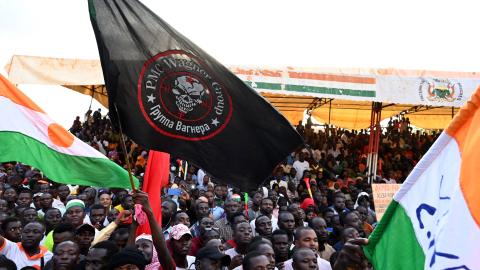In the summer of 2023, it looked for a moment that West Africa was at risk of a regional inter-state war of the sorts it had not seen since the 1990s. After a group of military officers overthrew the democratically elected president of Niger, Mohamed Bazoum, in late July, the regional bloc ECOWAS threatened a military intervention, backed by France, to restore Bazoum’s presidency. Niger’s new junta quickly turned to neighboring Mali and Burkina Faso, both military regimes that had turned against France and toward Russia over the previous two years, for promises of protection, resulting in the hasty announcement of an “Alliance of Sahel States” that pledged to defend Niger if the ECOWAS intervention went ahead.
The junta in Niger successfully called ECOWAS’s bluff and the war did not come to pass: ECOWAS nations have their own internal political, economic, and crises to keep them busy, the ECOWAS militaries are ill-prepared for a prolonged expeditionary mission, and the prospect of an interstate war would have been deeply unpopular at home.
But the regional situation remains volatile, and West Africa has avoided an interstate war only to see a continued and now accelerating, degradation of security conditions in the region.
A precarious situation in the “coup belt” and littorals
ECOWAS and Western sanctions remain in effect against Niger’s junta while the French—the former colonial power and traditional security partner for the Sahel states—have effectively been forced out of the region by the three Sahelian juntas. Mali’s regime has gone a step further by also kicking out the UN peacekeeping mission in the country and embracing the Wagner Group as its new partner for counterterrorism and regime security.
If a regional conflict would have been a hay day for the Sahel’s jihadist groups, the al-Qaeda-linked Jama’at Nasr al-Islam wal Muslimin (JNIM) and the Islamic State’s Sahel Province (ISSP), the current situation is also working to their advantage. Military regimes typically struggle to contain insecurity as an effect of their politicization, a dynamic which now appears to be playing out in Niger: JNIM and ISSP escalated attacks in western Niger in the month after the coup, including several large-scale attacks that occurred after Nigerien special forces units were reportedly repositioned from the frontlines to the capital to guard the new regime. The ongoing tensions between Niger and neighboring countries, principally Nigeria, similarly risk undermining the sorts of cross-border cooperation needed to contain jihadist groups.
The departure of French troops from the region and the forced withdrawal of the UN mission from Mali have also left a security vacuum that local militaries have struggled to fill. An ethnic Tuareg rebellion has resumed in the north of the country that JNIM is likely lending discrete support. A joint Malian-Wagner convoy has backfilled one of the key towns abandoned by UN peacekeepers in the north, but it will face significant challenges in holding the area and degrading JNIM units in the north, where the jihadists enjoy longstanding ties with some of the Tuareg rebels. More broadly, Wagner’s propensity for extreme, indiscriminate violence against noncombatants tends to backfire by driving communities into the arms of jihadist groups for protection.
The resurgence of the Tuareg conflict draws international attention once again to northern Mali, which was traditionally the epicenter of jihadist violence. But since the mid-2010s, the violence has shifted southward into central and southern Mali, to say nothing of neighboring states, and it continues to rage there. JNIM has intensified its operations against pro-government ethnic militias in recent months, and the group staged one of its most audacious complex attacks against Malian and Wagner forces at the airport in Gao in central Mali on September 8.JNIM is also quietly expanding in Mali’s western provinces as well, bringing the militants closer to the borders of Senegal and Mauritania, two of the few relatively stable states in the region. Meanwhile, close to half of Burkina Faso is now controlled by either JNIM or ISSP, according to the latest estimates, and the country’s ruling junta appears to have few ideas for combatting the insecurity beyond massacring civilians while it tries to stave off the next coup.
Of equally significant if not greater concern is the southward expansion of jihadists into the coastal West African states (albeit within the northern peripheries of those states—for now). The situation in Benin in particular has deteriorated in the past two years as JNIM has transitioned from using the country’s northern states as a base to support operations in neighboring Niger and Burkina Faso into an active theater of the insurgency in which the militants challenge state authority and recruit with the goal of eventually controlling territory.
A complex jihadist playing field in Nigeria
Jihadist dynamics within Africa’s most populous state and largest economy, Nigeria, are often siloed from discussions of the situation in the broader Sahel, but dynamics between the two regions are in fact interlinked. The jihadists in Nigeria do not control the same degree of territory as those in Mali or Burkina Faso and dynamics are somewhat in flux, with episodes of concerning jihadist expansion being undercut by intra-jihadist conflicts. Nonetheless, these developments bear close monitoring: After almost 15 years, Nigeria’s “Boko Haram” conflict is something of a permanent fixture of the region, even as it undergoes various transformations and its intensity ebbs and flows.
Broadly speaking, Nigeria suffers from violence from three principal jihadist groups, and the relative strength of each has changed in recent months. The original “Boko Haram” group, known by its acronym JAS, appeared to have suffered a fatal blow in May 2021 when its longtime leader Abubakar Shekau was killed by the rival faction, the Islamic State’s West Africa Province (ISWAP), which proceeded to rally a number of JAS commanders to its flag in the far northeastern state of Borno.
A little over two years later, things look quite different. The faction of JAS led by the commander known as Bakura Doro has gone from being an anachronistic holdout to ISWAP’s consolidation of control in Borno in 2021-22 to being an equal if not superior force to ISWAP now in control of a number of strategic locations around Lake Chad.
ISWAP, the strongest jihadist group in Nigeria since the mid-2010s and one that appeared particularly expansionist in 2022, has been on the losing end of this equation, as it has been forced to concede Lake Chad strongholds to Bakura since clashes with Bakura intensified in December 2022. ISWAP has been forced to relocate principally to Sambisa Forest in Borno state, once the stronghold of Abubakar Shekau’s JAS, where it has fewer opportunities to tax lucrative commerce and agricultural or piscatorial activity than in Lake Chad. The group, which conducted a string of attacks in central Nigeria for the first time in 2022, still has ambitions to conduct spectacular terror attacks outside of the northeast, but the Nigerian security forces, after initially being caught unprepared, have successfully foiled the latest attempts.
Meanwhile, the small al-Qaeda affiliate and JNIM ally that operates in northwestern Nigeria, Ansaru, was forced to revert to an underground phase of reconstitution in mid-2022 after miscalculating its relative power vis-à-vis local bandit gangs. After failing in its population-centric strategy in rural Kaduna state and being routed by local gangs, Ansaru fighters have resorted to collaborating with the bandits in cattle rustling and kidnapping for ransom. It is possible that some of these revenues are being systematically preserved to rebuild the group or even being sent to support JNIM’s operations in neighboring countries; but it may also be the case that most Ansaru fighters are now simply partnering with bandits as soldiers of fortune, which has often proven to be a lucrative alternative for Nigeria’s jihadists. Much as with ISWAP’s fitful expansion and JAS’s organizational uncertainty, time will tell whether Ansaru is truly reorganizing or simply fragmenting into the local criminal-militant milieu.
Conclusion
As we move into 2024, the regional security situation in West Africa looks grim. While dynamics in each country or province vary, on the whole, the region is witnessing more jihadist expansion than contraction. And it is not only jihadists but a cacophony of other non-state actors that are undermining regional states and contributing to inter-communal tensions. The political turbulence of repeated coups and the bellicose rhetoric between regional states, exacerbated by competition between global powers like Russia and France, distracts regional governments from addressing internal security at best and provides a pretext for them to engage in self-destructive policies at worst. Any sustainable improvement in the regional security situation will have to be rooted in an improvement in political conditions, both within and between the various West African nations.
The United States has limited options to contain the jihadist violence, let alone roll it back. Washington and Paris, traditionally working in lockstep in West Africa, took diverging approaches to the coup in Niger, with the former adopting a more pragmatic approach aimed at finding a compromise with the new junta while the latter encouraged its allies within ECOWAS to intervene militarily. Washington’s more cautious approach paid dividends insofar as a regional war was avoided, but the US is left negotiating with a recalcitrant junta that uses the language of transition to provide the thinnest cover for its desire to retain power, flirting with Russia and the neighboring juntas all the while.
Western powers increasingly see Chad as the last semi-stable holdout in the Sahel, but such optimism is likely misplaced given the chaos raging along just about every border of that brittle authoritarian state. The Western focus now is less on trying to reverse course in the landlocked Sahelian states than on trying to contain the violence and prevent it from spilling over into the more economically dynamic coastal states. The Biden administration has designated five coastal West African states including Ghana and Benin for funding under the Global Fragility Act as a means of bolstering their capacity to prevent and combat terrorism. Whether and in which ways such programs will better equip the coastal states to handle the encroaching jihadist threat remains to be seen.
While few would say it out loud, American policy these days increasingly seems to reflect a well-founded pessimism: The Sahel may not yet be entirely lost, but there is little to be gained in doubling down on the region’s fragile and fickle regimes.



















